Mostrar el registro sencillo del ítem
dc.contributor.author
Vicenzi, Nadia Pamela

dc.contributor.author
Corbalán, Valeria Elizabeth

dc.contributor.author
Miles, Donald Bailey

dc.contributor.author
Sinervo, Barry Raymond

dc.contributor.author
Ibarguengoytía, Nora

dc.date.available
2018-05-18T14:07:29Z
dc.date.issued
2017-02
dc.identifier.citation
Vicenzi, Nadia Pamela; Corbalán, Valeria Elizabeth; Miles, Donald Bailey; Sinervo, Barry Raymond; Ibarguengoytía, Nora; Range increment or range detriment?: Predicting potential changes in distribution caused by climate change for the endemic high-Andean lizard Phymaturus palluma; Elsevier; Biological Conservation; 206; 2-2017; 151-160
dc.identifier.issn
0006-3207
dc.identifier.uri
http://hdl.handle.net/11336/45531
dc.description.abstract
An increase in temperatures and frequency of drought events are predicted in the High Andes due to climate change. Species could respond with changes in its range, abundance and phenology. Here, we used a species distribution model to assess and predict the vulnerability to climate change of the endemic lizard Phymaturus palluma of the Andes. The model is based on a study of the thermoregulatory behaviour of the species. We measured body temperature (Tb) and assessed its relationship with micro-environmental temperatures to determine the main source of heat used by lizards. We also quantified the preferred temperature (Tp) and maximum and minimum critical temperatures (CTmax and CTmin), and collected operative temperature (Te). We used Tb, Tp and Te to calculate the effectiveness of thermoregulation. We linked these physiological variables with climatic variables obtained from a set of global climate layers. The model predicts a substantial reduction in the available habitat over the species current distributional range. However, the model also predicted new potential distribution areas towards the West Andes, at higher elevations. Nevertheless, because of the species specialized habits and low dispersal capability, we suggest the likelihood of expansion to these new sites is marginal. Thus, distribution shifts are unlikely to prevent extinction in Phymaturus. Conservation strategies should be focused in the protection of the current distribution areas that remain suitable in the different future climate projections. Additional data are needed to determine the potential for phenotypic plasticity to mitigate the probable population decline in this species.
dc.format
application/pdf
dc.language.iso
eng
dc.publisher
Elsevier

dc.rights
info:eu-repo/semantics/openAccess
dc.rights.uri
https://creativecommons.org/licenses/by-nc-sa/2.5/ar/
dc.subject
Andes
dc.subject
Phymaturus
dc.subject
Thermoregulatory Efficiency
dc.subject
Range Shift
dc.subject
Conservation
dc.subject.classification
Otras Ciencias Biológicas

dc.subject.classification
Ciencias Biológicas

dc.subject.classification
CIENCIAS NATURALES Y EXACTAS

dc.title
Range increment or range detriment?: Predicting potential changes in distribution caused by climate change for the endemic high-Andean lizard Phymaturus palluma
dc.type
info:eu-repo/semantics/article
dc.type
info:ar-repo/semantics/artículo
dc.type
info:eu-repo/semantics/publishedVersion
dc.date.updated
2018-04-18T15:10:27Z
dc.journal.volume
206
dc.journal.pagination
151-160
dc.journal.pais
Países Bajos

dc.journal.ciudad
Amsterdam
dc.description.fil
Fil: Vicenzi, Nadia Pamela. Consejo Nacional de Investigaciones Científicas y Técnicas. Centro Científico Tecnológico Conicet - Mendoza. Instituto Argentino de Investigaciones de las Zonas Áridas. Provincia de Mendoza. Instituto Argentino de Investigaciones de las Zonas Áridas. Universidad Nacional de Cuyo. Instituto Argentino de Investigaciones de las Zonas Áridas; Argentina
dc.description.fil
Fil: Corbalán, Valeria Elizabeth. Consejo Nacional de Investigaciones Científicas y Técnicas. Centro Científico Tecnológico Conicet - Mendoza. Instituto Argentino de Investigaciones de las Zonas Áridas. Provincia de Mendoza. Instituto Argentino de Investigaciones de las Zonas Áridas. Universidad Nacional de Cuyo. Instituto Argentino de Investigaciones de las Zonas Áridas; Argentina
dc.description.fil
Fil: Miles, Donald Bailey. Ohio University; Estados Unidos
dc.description.fil
Fil: Sinervo, Barry Raymond. University of California; Estados Unidos
dc.description.fil
Fil: Ibarguengoytía, Nora. Consejo Nacional de Investigaciones Científicas y Técnicas. Centro Científico Tecnológico Conicet - Patagonia Norte. Instituto de Investigaciones en Biodiversidad y Medioambiente. Universidad Nacional del Comahue. Centro Regional Universidad Bariloche. Instituto de Investigaciones en Biodiversidad y Medioambiente; Argentina
dc.journal.title
Biological Conservation

dc.relation.alternativeid
info:eu-repo/semantics/altIdentifier/doi/http://dx.doi.org/10.1016/j.biocon.2016.12.030
dc.relation.alternativeid
info:eu-repo/semantics/altIdentifier/url/https://www.sciencedirect.com/science/article/pii/S0006320716311235
Archivos asociados
